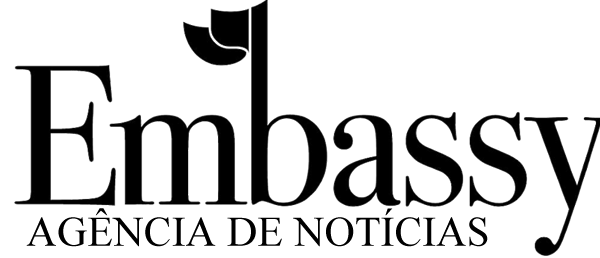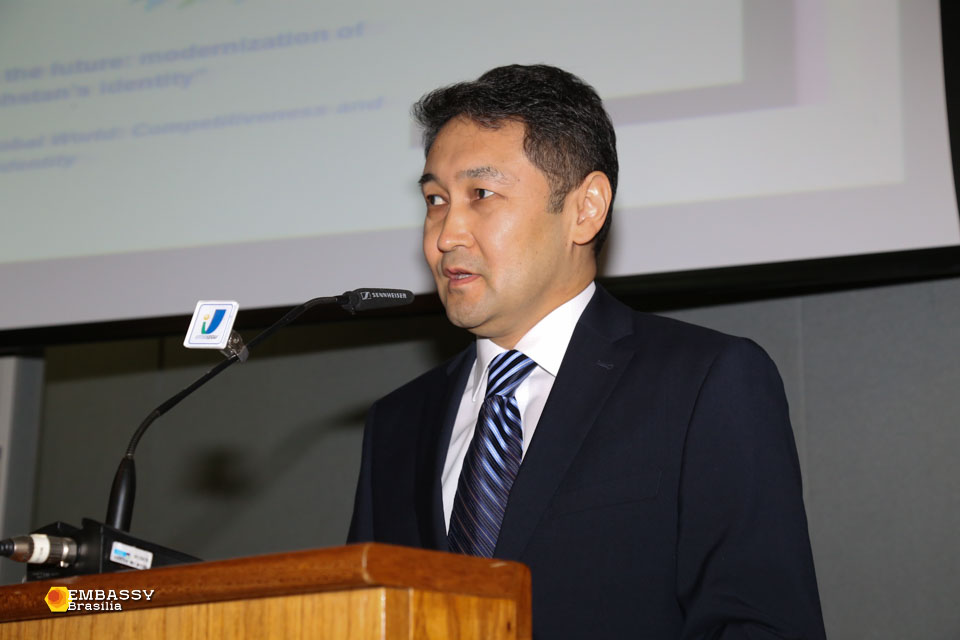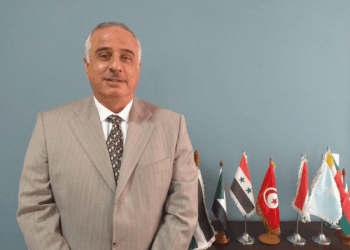Kairat Sarzhanov
Living in today’s world it is hard to imagine what we would do, if our ancestors did not invent script. The need for writing and intention to address following generation induced people to communicate through petroglyphic drawings, and further to reach alphabet, passing long way of evolution. To date alphabet is one of the most important discoveries of the mankind.
Each sovereign state has its own state language and alphabet that are considered to be an embodiment of its history, culture, tradition, customs and its national identity and wealth. The state language of Kazakhstan is Kazakh language, which belongs to the Turkic language family. Kazakh language currently uses the Cyrillic alphabet system, however, before the transition to Cyrillic in 1940, the Kazakh alphabet repeatedly changed its pattern by adapting to the requirements of a certain historical period. In the 6th – 7th centuries, the ancient Turkic peoples – ancestors, including modern Kazakhs, used the ancient Turkic runic letter, known as the Orkhon-Yenisei script.
Since the advent of Islam on the territory of modern Kazakhstan, in the 10th century, there has been a transition to Arabic alphabet, which was used up to the beginning of the 20th century. Arabic script writing is still used by Kazakhs living in China, Afghanistan and Iran. Since 1929, a new latin alphabet was introduced on the territory of Kazakhstan, known as “The Unified Turkic Alphabet”. Latin alphabet script lasted until 1939.
After more than 70 years, Kazakhstan decided to go back to Latin alphabet. In his program article “Course towards the future: modernization of Kazakhstan’s identity”, which was published in April this year, President of Kazakhstan Nursultan Nazarbayev launched a gradual transition of the Kazakh language to the Latin alphabet. The idea was by no means new. Kazakhstan public figures and specialists outlined it in the early years of independence. But then the society was not yet ready for such drastic changes. The question re-emerged on the agenda in 2006, when speaking at the Assembly of the People of Kazakhstan, the State leader noted that Latin alphabet dominates the world’s communication space, and urged specialists to resume the discussion of the possibility of switching to Latin alphabet. After that 2025, the exact date of transition to Latin alphabet, was specified in the Strategy “Kazakhstan – 2050”.
Why did we decide to return to Latin alphabet? Despite numerous guesses, the reasons are very pragmatic and logical. The decision is taken exclusively for practical reasons and meets the trends of the modern stage of development of Kazakhstan, the features of technological development in the modern world, which is of great importance for the scientific and educational progress in the 21st century. Latin alphabet is the most widely used writing system in the world and is used by approximately 70% of countries, i.e. it is part of international communication system.
The transition to Latin is also based on the need to increase the country’s competitiveness and attract investments. In the light of the implementation of the third modernization of Kazakhstan and the achievement of the goal of joining the 30 most developed countries of the world until 2050, the transition to Latin alphabet will promote Kazakhstan’s integration into the modern scientific, educational, technological and business communities, facilitate English and other based on Latin alphabet world languages’ learning, digitalization and computerization of the society. Moreover, language reform will enable foreigners to study Kazakh language. Kazakhstan is very attractive not only in terms of tourism, but also in terms of doing business, so every year the number of foreign companies that want to expand their economic ties with Kazakhstan grows. Due to this reason, many are willing now to learn Kazakh language.
Therefore it will be much easier for them to learn it through Latin alphabet. For example, in the Argentine city of Rosario, we have the Kazakhstan Cultural Center, which, under the leadership of our former compatriot Irina Vagner, successfully promotes Kazakhstan’s image and is a kind of “representation”, a link between Kazakhstan and Argentina. The transition of the state language to Latin inspired greater interest among the Argentines, especially the youth, who had repeatedly asked the Center to launch Kazakh language courses. With the transition to Latin alphabet, this idea may well become a reality.
Within the framework of the modernization of Kazakhstan’s identity program the challenge ahead is to translate world literature into Kazakh language and Kazakh literary works into world languages. The transition to Latin alphabet is intended to facilitate the solution of this task. Today the only work translated into Portuguese language by the Brazilian translator Marco Syrayama de Pinto is the Turkic prose epic “The book of my grandfather Korkut”. We hope that in the future translations of Kazakh literature, characterized by its epic and lyrical traditions, into Portuguese and Spanish will be more available and will contribute to the cultural and humanitarian rapprochement of our peoples. In other words, with the help of Latin alphabet we will approach the modern world culture.
From the linguistic point of view, the transition to Latin will ensure optimization of Kazakh alphabet, its grammatical and phonetic systems’ harmonization. The fact that almost all Turkic-speaking countries, such as Turkey, Azerbaijan, Uzbekistan, and Turkmenistan, switched to Latin script, shows that Latin alphabet more accurately reflects the phonetic structure of the Turkic languages. The alphabet reform will help modernize native speaker’s identity, strengthen the languages practical application and leave it as a legacy to the descendants.
The alphabet transformation is part of the modernization of public identity, aimed at ensuring nation’s successful development in the contemporary world order.
Kairat Sarzhanov- Ambassador of Kazakhstan in Brazil
Reforma linguística: caminho para a modernização da identidade da nação
Vivendo no mundo de hoje, é difícil imaginar o que faríamos, se nossos antepassados não inventassem o roteiro. A necessidade de escrever e a intenção de abordar a geração seguinte induziu as pessoas a se comunicar através de desenhos petroglyphic, e ainda chegar ao alfabeto, passando por um longo caminho de evolução. Até hoje, o alfabeto é uma das descobertas mais importantes da humanidade.
Cada estado soberano tem sua própria língua de estado e alfabeto que são considerados uma encarnação de sua história, cultura, tradição, costumes e sua identidade e riqueza nacional. A língua estadual do Cazaquistão é a língua cazaque, que pertence à família da língua turca. A língua cazaque atualmente usa o sistema de alfabeto cirílico, no entanto, antes da transição ao cirílico em 1940, o alfabeto cazaque mudou repetidamente seu padrão adaptando-se aos requisitos de um certo período histórico. Nos séculos VI a VII, os antigos povos turcos – ancestrais, incluindo os cazaques modernos, usavam a antiga letra rúnica turca, conhecida como o roteiro de Orkhon-Yenisei.
Desde o advento do islamismo no território do Cazaquistão moderno, no século X, houve uma transição para o alfabeto árabe, que foi usado até o início do século XX. A escrita de roteiro árabe ainda é usada por cazaques que vivem na China, no Afeganistão e no Irã. Desde 1929, um novo alfabeto latino foi introduzido no território do Cazaquistão, conhecido como “O alfabeto turco unificado”. O script do alfabeto latino durou até 1939.
Depois de mais de 70 anos, o Cazaquistão decidiu voltar ao alfabeto latino. Em seu artigo de programa “Curso para o futuro: modernização da identidade do Cazaquistão”, publicado em abril deste ano, o presidente do Cazaquistão, Nursultan Nazarbayev, lançou uma transição gradual da língua cazaque para o alfabeto latino. A ideia não era nova. As figuras públicas e os especialistas do Cazaquistão descrevem isso nos primeiros anos da independência. Mas a sociedade ainda não estava pronta para mudanças tão drásticas.
A questão voltou a surgir na agenda em 2006, quando falava na Assembléia do Povo do Cazaquistão, o líder do Estado observou que o alfabeto latino domina o espaço de comunicação do mundo e exortou especialistas a retomar a discussão sobre a possibilidade de mudar para o alfabeto latino . Depois disso, 2025, a data exata de transição para o alfabeto latino, foi especificada na Estratégia “Cazaquistão – 2050”.
Por que decidimos retornar ao alfabeto latino? Apesar de muitas suposições, os motivos são muito pragmáticos e lógicos. A decisão é tomada exclusivamente por razões práticas e atende as tendências do estágio moderno de desenvolvimento do Cazaquistão, as características do desenvolvimento tecnológico no mundo moderno, que é de grande importância para o progresso científico e educacional no século XXI. O alfabeto latino é o sistema de escrita mais utilizado no mundo e é usado por aproximadamente 70% dos países, ou seja, faz parte do sistema de comunicação internacional.
A transição para o latim também se baseia na necessidade de aumentar a competitividade do país e atrair investimentos. À luz da implementação da terceira modernização do Cazaquistão e da consecução do objetivo de se juntar aos 30 países mais desenvolvidos do mundo até 2050, a transição para o alfabeto latino promoverá a integração do Cazaquistão nos setores científico, educacional, tecnológico e empresarial moderno comunidades, facilitam aprendizado o inglês e outros línguas baseados na alfabeto latino, digitalização e informatização da sociedade. Além disso, a reforma da linguagem permitirá que os estrangeiros estudem a língua do Cazaquistão.
O Cazaquistão é muito atraente não só em termos de turismo, mas também em termos de negócios, por isso, cada ano, o número de empresas estrangeiras que querem expandir seus laços econômicos com o Cazaquistão cresce. Devido a esse motivo, muitos estão dispostos agora a aprender a língua do Cazaquistão. Portanto, será muito mais fácil para eles aprenderem com o alfabeto latino. Por exemplo, na cidade Rosario da Argentina, temos o Centro Cultural do Cazaquistão, que, sob a liderança da nossa ex-compatriota Irina Vagner, promove com sucesso a imagem do Cazaquistão e é uma espécie de “representação”, um elo entre o Cazaquistão e a Argentina. A transição da língua estadual para o latim inspirou maior interesse entre os argentinos, especialmente os jovens, que repetidamente pediram ao Centro que lançasse cursos de língua cazaque. Com a transição para o alfabeto latino, essa idéia pode tornar-se realidade.
No âmbito da modernização do programa de identidade do Cazaquistão, o desafio à frente é traduzir a literatura mundial para a literatura cazaque e obras literárias cazaques para as línguas mundiais. A transição para o alfabeto latino tem como objetivo facilitar a solução dessa tarefa. Hoje, o único trabalho traduzido para a língua portuguesa pelo tradutor brasileiro Marco Syrayama de Pinto é a epopeia de prosa turca “O livro de dede Korkut”. Esperamos que, no futuro, as traduções da literatura cazaques, caracterizadas por suas tradições épicas e líricas, em português e espanhol estarão mais disponíveis e contribuirão para a aproximação cultural e humanitária de nossos povos. Em outras palavras, com a ajuda do alfabeto latino, abordaremos a cultura mundial moderna.
Do ponto de vista linguístico, a transição para o latim assegurará a otimização do alfabeto cazaque, sua harmonização dos sistemas gramaticais e fonéticos. O fato de que quase todos os países de língua turca, como a Turquia, o Azerbaijão, o Uzbequistão e o Turquemenistão, mudaram para o roteiro latino, mostra que o alfabeto latino reflete mais precisamente a estrutura fonética das línguas turcas. A reforma do alfabeto ajudará a modernizar a identidade do falante nativo, fortalecer a aplicação prática dos idiomas e deixá-la como um legado para os descendentes.A transformação do alfabeto faz parte da modernização da identidade pública, visando assegurar o desenvolvimento bem sucedido da nação na ordem mundial contemporânea.






